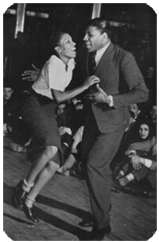
Who among us wouldn't be proud to say they could Lindy Hop? I surely would!
Beyond being a hoot, it looks to be a hazard! I think myself adventurous, so (mastering?/attempting?) this vigorous dance is definitely on my bucket list.

Lindy Hoppers - Jet Magazine - 1958
About the Lindy Hop (from Wikipedia:)
The Lindy Hop was born in black communities in Harlem, New York in the United States from about 1927 into the early 1930s from four possible sources: the breakaway, the Charleston, the Texas Tommy, and the hop.
The Lindy Hop is based on the popular Charleston and named for Charles Lindbergh's Atlantic crossing in 1927. It evolved in New York City in the 1920s and '30s and originally evolved with the jazz music of that time. Lindy was a fusion of many dances that preceded it or were popular during its development but is mainly based on jazz, tap, breakaway and Charleston. It is frequently described as a jazz dance and is a member of the swing dance family.
In its development, the Lindy Hop combined both partnered and solo dancing by using the movements and improvisation of black dances along with the formal eight-count structure of European partner dances. This is most clearly illustrated in the Lindy's basic step, the swingout. In this step's open position, each dancer is generally connected hand-to-hand; in its closed position, men and women are connected as though in an embrace.
Revived in the 1980s by American, Swedish, and British dancers, the Lindy Hop is now represented by dancers and loosely affiliated grass roots organizations found in North America, South America, Europe, Asia, and Oceania.

Leon James and Willa Mae Ricker demonstrating the Lindy Hop for a 1943 issue of Life Magazine.

Charles Alston (1907 - 1977)
Watercolor, 9” x 13

Jeunesse (Youth) by Palmer Hayden
Painted during the Harlem Renaissance
http://www.swingcville.com/history-of-lindy-hop/



















0 comments:
Post a Comment